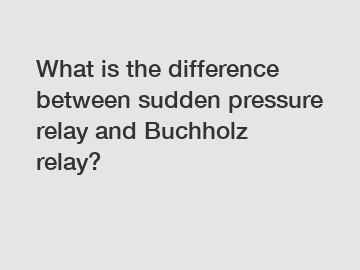What is the difference between sudden pressure relay and Buchholz relay?
What is the difference between sudden pressure relay and Buchholz relay?
The sudden pressure relay and Buchholz relay are two important devices used in power transformers for the protection against internal faults. While both relays serve the purpose of detecting abnormal conditions within the transformer, they differ in terms of their functions and principles of operation.
To begin with, the sudden pressure relay is primarily used to detect sudden increases in pressure within the transformer tank. This usually occurs due to internal faults such as short circuits or arcing, which generate high amounts of gas and cause a rapid rise in pressure. The sudden pressure relay is designed to sense this pressure increase and activate an alarm or trip the transformer to prevent further damage.

On the other hand, the Buchholz relay is specifically designed to detect the accumulation of gas or oil in the transformer's oil conservator tank. Unlike the sudden pressure relay, the Buchholz relay is more concerned with slow-paced faults, such as partial discharges or slow leakage of oil. When these faults occur, they generate gases or oil bubbles, which rise through the oil containment system and trigger the operation of the Buchholz relay. The device acts as an early warning system by detecting these gas or oil accumulations and initiating an alarm or trip signal to safeguard the transformer.
The fundamental difference in the principles of operation stems from the nature of the faults they are designed to detect. The sudden pressure relay reacts to faults that cause a high-pressure surge instantly, providing a quick response to catastrophic events. On the other hand, the Buchholz relay detects gradual faults that occur over a longer period. By doing so, it provides a valuable diagnostic tool that can indicate the severity and type of fault occurring within the transformer.
The significance of differentiating between these relays lies in their ability to provide valuable information about the transformer's condition. The sudden pressure relay is more suitable for detecting large-scale faults that have an immediate impact on the transformer's stability. By identifying such faults quickly, it enables prompt action to be taken to prevent further damage or potential hazards.
Meanwhile, the Buchholz relay plays a pivotal role in detecting slow-paced, hidden faults that may go unnoticed by other protective devices. By monitoring the accumulation of gases or oil, it alerts operators to the potential presence of faults such as insulation degradation, faulty tap changers, or low oil level. This early warning system helps in identifying the root cause and taking appropriate measures to rectify the fault before it escalates into a catastrophic failure.
In conclusion, the difference between the sudden pressure relay and Buchholz relay lies in their primary functions and principles of operation. While the sudden pressure relay is designed to detect sudden increases in pressure, the Buchholz relay detects the accumulation of gas or oil in the transformer's oil conservator tank. Understanding these differences is crucial for proper transformer protection, as each relay serves a unique purpose in safeguarding the transformer from different types of faults.
If you want to learn more, please visit our website two way flow control valve supplier, tubular check valve, wholesale Hydraulic Control Check Valve Supplier.



Comments
0